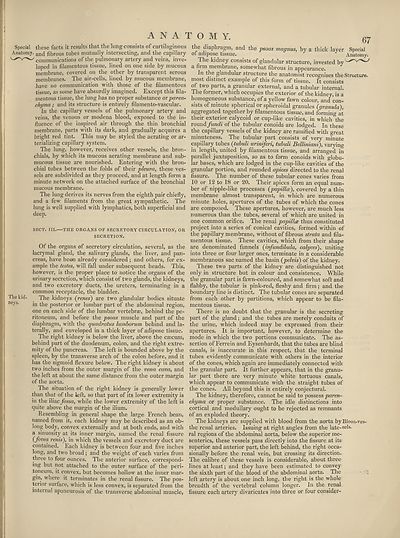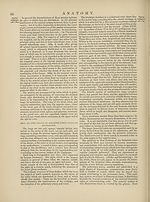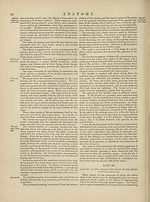Encyclopaedia Britannica > Volume 3, Anatomy-Astronomy
(75) Page 67
Download files
Complete book:
Individual page:
Thumbnail gallery: Grid view | List view

ANATOMY.
Special these facts it results that the lung consists of cartilaginous
Anatomy. an(j fibrous tubes mutually intersecting, and the capillary
communications of the pulmonary artery and veins, inve-
loped in filamentous tissue, lined on one side by mucous
membrane, covered on the other by transparent serous
membranes. The air-cells, lined by mucous membrane,
have no communication with those of the filamentous
tissue, as some have absurdly imagined. Except this fila¬
mentous tissue, the lung has no proper substance ox paren¬
chyma ; and its structure is entirely filamento-vascular.
In the capillary vessels of the pulmonary artery and
veins, the venous or modena blood, exposed to the in¬
fluence of the inspired air through the thin bronchial
membrane, parts with its dark, and gradually acquires a
bright red tint. This may be styled the aerating or ar-
terializing capillary system.
The lung, however, receives other vessels, the bron-
chials, by which its mucous aerating membrane and sub¬
mucous tissue are nourished. Entering with the bron¬
chial tubes between the folds of their pleura, these ves¬
sels are subdivided as they proceed, and at length form a
minute network on the attached surface of the bronchial
mucous membrane.
The lung derives its nerves from the eighth pair chiefly,
and a few filaments from the great sympathetic. The
lung is well supplied with lymphatics, both superficial and
deep.
SECT. III.—THE ORGANS OF SECRETORY CIRCULATION, OR
SECRETION.
Of the organs of secretory circulation, several, as the
lacrymal gland, the salivary glands, the liver, and pan¬
creas, have been already considered ; and others, for ex¬
ample the testes, will fall under subsequent heads. This,
however, is the proper place to notice the organs of the
urinary secretion, which consist of two glands, the kidneys,
and two excretory ducts, the ureters, terminating in a
common receptacle, the bladder.
The kidneys (renes) are two glandular bodies situate
in the posterior or lumbar part of the abdominal region,
one on each side of the lumbar vertebras, behind the pe¬
ritoneum, and before the psoas muscle and part of the
diaphragm, with the quadratus lumborum behind and la¬
terally, and enveloped in a thick layer of adipose tissue.
The right kidney is below the liver, above the caecum,
behind part of the duodenum, colon, and the right extre¬
mity of the pancreas. The left is bounded above by the
spleen, by the transverse arch of the colon before, and it
has the sigmoid flexure below. The right kidney is about
two inches from the outer margin of the vena cava, and
the left at about the same distance from the outer margin
of the aorta.
The situation of the right kidney is generally lower
than that of the left, so that part of its lower extremity is
in the iliac fossa, while the lower extremity of the left is
quite above the margin of the ilium.
Resembling in general shape the large French bean,
named from it, each kidney may be described as an ob¬
long body, convex externally and at both ends, and with
a sinuosity at its inner margin, named the renal fissure
{fovea rents), in which the vessels and excretory duct are
contained. Each kidney is between four and five inches
long, and two broad; and the weight of each varies from
three to four ounces. The anterior surface, correspond¬
ing but not attached to the outer surface of the peri¬
toneum, it convex, but becomes hollow at the inner mar¬
gin, where it terminates in the renal fissure. The pos¬
terior surface, which is less convex, is separated from the
internal aponeurosis of the transverse abdominal muscle,
67
The kid¬
neys.
the diaphragm, and the psoas magnus, by a thick layer Special
of adipose tissue. Anatomy^
The kidney consists of glandular structure, invested by
a firm membrane, somewhat fibrous in appearance.
In the glandular structure the anatomist recognises the Structure,
most distinct example of this form of tissue. It consists
of two parts, a granular external, and a tubular internal.
The former, which occupies the exterior of the kidney, is a
homogeneous substance, of a yellow fawn colour, and con¬
sists of minute spherical or spheroidal granules {granula),
aggregated together by filamentous tissue, and forming at
their exterior calycoid or cup-like cavities, in which the
round fundi of the tubular conoids are lodged. In these
the capillary vessels of the kidney are ramified with great
minuteness. The tubular part consists of very minute
capillary tubes {tubuli uriniferi, tubuli Belliniani), varying
in length, united by filamentous tissue, and arranged in
parallel juxtaposition, so as to form conoids with globu¬
lar bases, which are lodged in the cup-like cavities of the
granular portion, and rounded apices directed to the renal
fissure. The number of these tubular cones varies from
10 or 12 to 18 or 20. Their apices form an equal num¬
ber of nipple-like processes {papillce), covered by a thin
membrane almost transparent, in which are numerous
minute holes, apertures of the tubes of which the cones
are composed. These apertures, however, are much less
numerous than the tubes, several of which are united in
one common orifice. The renal papillae thus constituted
project into a series of conical cavities, formed within of
the papillary membrane, without of fibrous strata and fila¬
mentous tissue. These cavities, which from their shape
are denominated funnels {infundibula, calyces), uniting
into three or four larger ones, terminate in a considerable
membranous sac named the basin {pelvis) of the kidney.
These two parts of the kidney are distinguished not
only in structure but in colour and consistence. While
the granular part is fawn-coloured, and somewhat soft and
flabby, the tubular is pink-red, fleshy and firm; and the
boundary line is distinct. The tubular cones are separated
from each other by partitions, which appear to be fila¬
mentous tissue.
There is no doubt that the granular is the secreting
part of the gland; and the tubes are merely conduits of
the urine, which indeed may be expressed from their
apertures. It is important, however, to determine the
mode in which the two portions communicate. The as¬
sertion of Ferrein and Eysenhardt, that the tubes are blind
canals, is inaccurate in this respect, that the terminal
tubes evidently communicate with others in the interior
of the cones, which again are immediately connected with
the granular part. It further appears, that in the granu¬
lar part there are very minute white tortuous canals,
which appear to communicate with the straight tubes of
the cones. All beyond this is entirely conjectural.
The kidney, therefore, cannot be said to possess paren¬
chyma or proper substance. The idle distinctions into
cortical and medullary ought to be rejected as remnants
of an exploded theory.
The kidneys are supplied with blood from the aorta byBlooa-ves-
the renal arteries. Issuing at right angles from the late-sels.
ral regions of the abdominal aorta, below the superior me¬
senteries, these vessels pass directly into the fissure at its
superior and anterior part, the left behind, the right occa¬
sionally before the renal vein, but crossing its direction.
The calibre of these vessels is considerable, about three
lines at least; and they have been estimated to convey
the sixth part of the blood of the abdominal aorta. The
left artery is about one inch long, the right is the whole
breadth of the vertebral column longer. In the renal
fissure each artery divaricates into three or four consider-
Special these facts it results that the lung consists of cartilaginous
Anatomy. an(j fibrous tubes mutually intersecting, and the capillary
communications of the pulmonary artery and veins, inve-
loped in filamentous tissue, lined on one side by mucous
membrane, covered on the other by transparent serous
membranes. The air-cells, lined by mucous membrane,
have no communication with those of the filamentous
tissue, as some have absurdly imagined. Except this fila¬
mentous tissue, the lung has no proper substance ox paren¬
chyma ; and its structure is entirely filamento-vascular.
In the capillary vessels of the pulmonary artery and
veins, the venous or modena blood, exposed to the in¬
fluence of the inspired air through the thin bronchial
membrane, parts with its dark, and gradually acquires a
bright red tint. This may be styled the aerating or ar-
terializing capillary system.
The lung, however, receives other vessels, the bron-
chials, by which its mucous aerating membrane and sub¬
mucous tissue are nourished. Entering with the bron¬
chial tubes between the folds of their pleura, these ves¬
sels are subdivided as they proceed, and at length form a
minute network on the attached surface of the bronchial
mucous membrane.
The lung derives its nerves from the eighth pair chiefly,
and a few filaments from the great sympathetic. The
lung is well supplied with lymphatics, both superficial and
deep.
SECT. III.—THE ORGANS OF SECRETORY CIRCULATION, OR
SECRETION.
Of the organs of secretory circulation, several, as the
lacrymal gland, the salivary glands, the liver, and pan¬
creas, have been already considered ; and others, for ex¬
ample the testes, will fall under subsequent heads. This,
however, is the proper place to notice the organs of the
urinary secretion, which consist of two glands, the kidneys,
and two excretory ducts, the ureters, terminating in a
common receptacle, the bladder.
The kidneys (renes) are two glandular bodies situate
in the posterior or lumbar part of the abdominal region,
one on each side of the lumbar vertebras, behind the pe¬
ritoneum, and before the psoas muscle and part of the
diaphragm, with the quadratus lumborum behind and la¬
terally, and enveloped in a thick layer of adipose tissue.
The right kidney is below the liver, above the caecum,
behind part of the duodenum, colon, and the right extre¬
mity of the pancreas. The left is bounded above by the
spleen, by the transverse arch of the colon before, and it
has the sigmoid flexure below. The right kidney is about
two inches from the outer margin of the vena cava, and
the left at about the same distance from the outer margin
of the aorta.
The situation of the right kidney is generally lower
than that of the left, so that part of its lower extremity is
in the iliac fossa, while the lower extremity of the left is
quite above the margin of the ilium.
Resembling in general shape the large French bean,
named from it, each kidney may be described as an ob¬
long body, convex externally and at both ends, and with
a sinuosity at its inner margin, named the renal fissure
{fovea rents), in which the vessels and excretory duct are
contained. Each kidney is between four and five inches
long, and two broad; and the weight of each varies from
three to four ounces. The anterior surface, correspond¬
ing but not attached to the outer surface of the peri¬
toneum, it convex, but becomes hollow at the inner mar¬
gin, where it terminates in the renal fissure. The pos¬
terior surface, which is less convex, is separated from the
internal aponeurosis of the transverse abdominal muscle,
67
The kid¬
neys.
the diaphragm, and the psoas magnus, by a thick layer Special
of adipose tissue. Anatomy^
The kidney consists of glandular structure, invested by
a firm membrane, somewhat fibrous in appearance.
In the glandular structure the anatomist recognises the Structure,
most distinct example of this form of tissue. It consists
of two parts, a granular external, and a tubular internal.
The former, which occupies the exterior of the kidney, is a
homogeneous substance, of a yellow fawn colour, and con¬
sists of minute spherical or spheroidal granules {granula),
aggregated together by filamentous tissue, and forming at
their exterior calycoid or cup-like cavities, in which the
round fundi of the tubular conoids are lodged. In these
the capillary vessels of the kidney are ramified with great
minuteness. The tubular part consists of very minute
capillary tubes {tubuli uriniferi, tubuli Belliniani), varying
in length, united by filamentous tissue, and arranged in
parallel juxtaposition, so as to form conoids with globu¬
lar bases, which are lodged in the cup-like cavities of the
granular portion, and rounded apices directed to the renal
fissure. The number of these tubular cones varies from
10 or 12 to 18 or 20. Their apices form an equal num¬
ber of nipple-like processes {papillce), covered by a thin
membrane almost transparent, in which are numerous
minute holes, apertures of the tubes of which the cones
are composed. These apertures, however, are much less
numerous than the tubes, several of which are united in
one common orifice. The renal papillae thus constituted
project into a series of conical cavities, formed within of
the papillary membrane, without of fibrous strata and fila¬
mentous tissue. These cavities, which from their shape
are denominated funnels {infundibula, calyces), uniting
into three or four larger ones, terminate in a considerable
membranous sac named the basin {pelvis) of the kidney.
These two parts of the kidney are distinguished not
only in structure but in colour and consistence. While
the granular part is fawn-coloured, and somewhat soft and
flabby, the tubular is pink-red, fleshy and firm; and the
boundary line is distinct. The tubular cones are separated
from each other by partitions, which appear to be fila¬
mentous tissue.
There is no doubt that the granular is the secreting
part of the gland; and the tubes are merely conduits of
the urine, which indeed may be expressed from their
apertures. It is important, however, to determine the
mode in which the two portions communicate. The as¬
sertion of Ferrein and Eysenhardt, that the tubes are blind
canals, is inaccurate in this respect, that the terminal
tubes evidently communicate with others in the interior
of the cones, which again are immediately connected with
the granular part. It further appears, that in the granu¬
lar part there are very minute white tortuous canals,
which appear to communicate with the straight tubes of
the cones. All beyond this is entirely conjectural.
The kidney, therefore, cannot be said to possess paren¬
chyma or proper substance. The idle distinctions into
cortical and medullary ought to be rejected as remnants
of an exploded theory.
The kidneys are supplied with blood from the aorta byBlooa-ves-
the renal arteries. Issuing at right angles from the late-sels.
ral regions of the abdominal aorta, below the superior me¬
senteries, these vessels pass directly into the fissure at its
superior and anterior part, the left behind, the right occa¬
sionally before the renal vein, but crossing its direction.
The calibre of these vessels is considerable, about three
lines at least; and they have been estimated to convey
the sixth part of the blood of the abdominal aorta. The
left artery is about one inch long, the right is the whole
breadth of the vertebral column longer. In the renal
fissure each artery divaricates into three or four consider-
Set display mode to:
![]() Universal Viewer |
Universal Viewer | ![]() Mirador |
Large image | Transcription
Mirador |
Large image | Transcription
Images and transcriptions on this page, including medium image downloads, may be used under the Creative Commons Attribution 4.0 International Licence unless otherwise stated. ![]()
| Encyclopaedia Britannica > Encyclopaedia Britannica > Volume 3, Anatomy-Astronomy > (75) Page 67 |
|---|
| Permanent URL | https://digital.nls.uk/193758323 |
|---|
| Attribution and copyright: |
|
|---|---|
| Shelfmark | EB.16 |
|---|---|
| Description | Ten editions of 'Encyclopaedia Britannica', issued from 1768-1903, in 231 volumes. Originally issued in 100 weekly parts (3 volumes) between 1768 and 1771 by publishers: Colin Macfarquhar and Andrew Bell (Edinburgh); editor: William Smellie: engraver: Andrew Bell. Expanded editions in the 19th century featured more volumes and contributions from leading experts in their fields. Managed and published in Edinburgh up to the 9th edition (25 volumes, from 1875-1889); the 10th edition (1902-1903) re-issued the 9th edition, with 11 supplementary volumes. |
|---|---|
| Additional NLS resources: |
|

